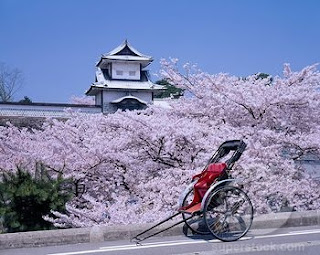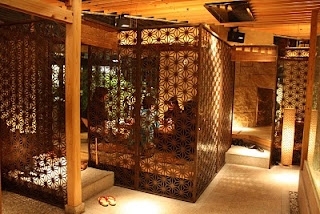Sabtu, 18 Juni 2011
District of Kanazawa Hightlights
Do you like this story?
Kanazawa Hightlights
executive summary by Darmansjah godjali
A young woman in kimono hangs a sign outside her teahouse in the Higashi Chaya-Gai district of Kanazawa.
Today I felt better when I woke up, which happened to be in time for the hotel breakfast. Although it was my third day staying here, I had yet to avail myself of the free meal. I’m glad I did, as the quality, freshness, and healthfulness of the buffet was in start contrast to what I’m used to having in the U.S. – or even in Vietnam, for that matter.
A lone crane, perched on a slab of rock jutting out of the river.
I chose a selection of lettuce, tuna fish with almonds, scrambled eggs, fish cake wrapped in kombu and cucumber, salmon, green beans, steamed rice, orange, and grapes. It might sound like a lot, but the portions were so small that it wasn’t much at all. Not a bad start to the day, right?
About twenty minutes later I was walking to Kanazawa station to buy another day’s Bus Loop pass. I headed for the Higashi chaya-gai geisha district near the Asano River. In fact, the bus dropped me off at the Asanogawa Bridge (stop #6), which is charming enough to be a sightseeing destination in its own right.
From the bridge to the geisha quarter was only a three-minute walk, and I was early enough getting there that I basically had the area to myself.
The area, nearly 200 years old, was established by the feudal government as a pleasure quarter for wealthy merchants and educated men – upper society at the time, in other words. They would come to watch geishas perform the koto and shamisen, dance, sing songs from the Noh stage, recite poetry (tanka and haikai), and do the tea ceremony.
These old teahouses (ochaya) have long since been transformed into restaurants and other businesses, though even today some geishas continue their old traditions here.
The ochaya are well-kept and quite elegant with their latticed, sliding doors and windows and tiled roofs, and are reminiscent in some ways of the machiya one finds in Kyoto. Shima has a ¥400 entrance fee, but it’s well worth it. I found the teahouse beautiful and fascinating, even though there wasn’t much information in English available.
I wandered around taking photos, even explored the surrounding neighborhood and some of its temples, before returning to the geisha quarter (it only covers about two blocks) and entering Ochaya Shima, one of the more famous geisha houses.
The front of Ochaya Shima, built in 1820.
I can see how overexuberant tourists could be a problem. (I think they mean "climb down.")
After leaving the ochaya I walked along the Asano River some, exploring the old houses above its banks and having a look at some of its bridges. Again, the area is very charming, and I’d like to come back at dusk when the lanterns wink on and the late afternoon hues give a different color scheme to the neighborhood.
From here, though it had started to rain slightly, I headed down the road to see two more places: Sakuda Gold & Silver Leaf Company and the Ohi Pottery Museum. Sakuda was interesting, especially the second floor where I received an explanation in English about the process of making gold leaf – a tradition dating back to 1593 in Kanazawa, which produces the vast majority of gold leaf used throughout Japan. The ground floor is product display area, and while the many commercial uses of gold leaf are interesting, I found most of the products a bit chintzy-looking. But it was free – as was a cup of gold-flecked tea I was given – and worth checking out.
The Ohi pottery museum wasn’t free, and its ¥700 ($8.32) admission fee was not at all worth it. There were no English explanations for the pottery on display, and there was very little to see in the museum anyway. There’s a gallery in front of the museum, but the pieces on sale were way, way beyond my price range.
I hopped on the bus again and headed to stop #10, where I’d been two days earlier, and walked past the 21st Century Museum of Contemporary Art to see the Ishikawa Noh Museum. It’s a nice building with a sleek interior space, but I found the displays underwhelming. I couldn’t get the video player on the second floor to turn on, and the main exhibition room didn’t seem to have as much on display as pictured in its brochure. The museum is only ¥300 to enter, so I suppose it might be worth a trip if you’re in the area.
Across the street I followed a skittish cat to the entrance of the Ishikawa Modern Literature Museum, which was ¥350 to enter. Although it only takes about 10 minutes to see, I found it interesting, in part thanks to the English-language brochure I was given. Ishikawa prefecture’s three most famous writers are Izumi Kyoka, Tokuda Shusei, and Murou Saisei, but the museum also introduces visitors to many other important local writers.
By this point I was near Korinbo, or Kanazawa’s business district, so I walked around here as well. There was some interesting sculpture on display, such as this multi-headed “Wisdom” piece. Had I been able to get my camera out sooner, I would have captured the boy in the photo below “picking the nose of wisdom.” Actually, he picked all five noses.
I heard music nearby and headed in that direction. Note the little girl on stage with the flute. At first I thought she was playing, and was amazed, but then I realized that she was mimicking the woman on the first step of the stage who was doing the actual playing.
Behind this was a person (I presume) in a multi-colored cartoony get-up dancing to the music and greeting customers to a department store. I have no idea what it was meant to represent.
About five minutes from here, on my way toward Omicho market, and set back a block from the main road I was walking down, I came across Oyama Jinja Shrine. It was an interesting shrine, in part for its startling architecture, and that, along with the site’s pond, shaded garden, and various sculptures, really make it worth seeing. I’ll let the photos below speak for themselves.
I was close enough to Omicho Market at this point that I chose to keep walking rather than take another bus. When I reached the market, the first place I bumped into was this takoyaki stand.
At ¥420 ($4.99) for eight pieces, that seemed like about the cheapest lunch I was going to find, so I ordered some and took them back to my hotel. Maybe not the best food to have a day after suffering from food poisoning…but nothing bad happened afterward, so ha!
I rested at my hotel for about two hours, showered, changed clothes, then used my day pass on the Loop Bus again to see the Saigawa River (stops #12 and 13) and some of the sites in that part of Kanazawa.
There's a hawk atop that telephone pole. It was screeching the whole time I was there. Maybe it was telling me something in hawk language, like, "Hey! There's ice cream down the street! Go get some before it's gone!"
My primary destination was actually the Kutani Kosen Pottery Studio and Kiln, but the area has other attractions, such as the Nishi Chaya District, another enclave of restored (and, it has to be said, less impressive) geisha houses.
I made my way fairly quickly through Nishi Chaya, though I stopped in the free Nishi Chaya Shiryokan Museum and was shown around by an old gentleman who was fluent in English. (He’d taught Japanese in Madison, Wisconsin, and in Sydney, Australia, for several years.) The museum wasn’t much, but I had interesting conversations with my guide.
About three short, winding, canal-meandering blocks from here one finds the Kutani Kosen Pottery Studio and Kiln. I love Japanese potteries, and this one, too, was very interesting to me.
Complicated but amazing recycling system.
The family who operates this studio and kiln has been doing it for generations. In fact, they had been in service to the Kaga lord since 1650, but once the Edo period ended and the family lost its sponsorship, in 1870 they opened this as a private enterprise.
A young man who spoke English well showed me around. He’s his parents’ eldest son and is carrying on the pottery tradition. His father first instructed him in pottery-making at the age of three, and while this young man also has a son aged three, he won’t be introducing him to the trade for another few years yet. It’s quite a famous studio, and has been honored with visits by the current emperor and empress, former Prime Minister Koizumi, and ambassadors from around the world. (The current U.S. ambassador visited the studio, but unfortunately didn’t buy much.) Everything made here is done by hand, using natural materials. I bought two sake cups and a small, deep dish for serving small items.
It was time to go home after this, so I walked back to the bus stop to catch a ride back to Kanazawa Station. I was eyed and barked at by a dog on a rooftop – why he focused on me and not a Japanese person, I have no idea; I guess he can sniff out sweaty tourists – and then took my time passing over Saigawa-Ohashi Bridge, whose lanterns had just flickered on.
For dinner I stuck close to home. I decided to try an izakaya called Daiba, which might not have been the best choice. There was no English menu, which normally doesn’t bother me, but in this case it gave me a bit of trouble.
I’m familiar enough with Japanese food and language that I was able to order grilled salted sanma fish and gasuebi (a kind of shrimp), leek and chicken yakitori, and draft Ebisu beer.
Later in the meal I tried to order a glass of Kanazawa sake, but the waitress, who seemed uncomfortable taking my order, asked the young counter chef to “translate,” but he kept saying that what I wanted to order was nihonshu, or shochu, not sake, despite my protests. In the end I thought that maybe nihonshu here meant sake, so rather than protest any longer I acceded to his brusk words. No surprise, I ended up with shochu mixed with water and ice, and not sake.
In my head I’d been adding up the bill…incorrectly, it turned out. The beer cost ¥630, the sanma ¥450, the yakitori ¥300, the shrimp ¥530, and the shochu ¥630. I also had a service charge of ¥360 tacked on. The total for my “meal” came to ¥2900 ($34.48). I left hungry, unable to figure out the bill, and not in the mood to recommend this place, though admittedly the problems I had were partly my fault.
Oh, and I totally freaked out the young man working at the cashier when I took a moment to go over the bill and asked him what two of the charges referred to. He moved his body left to right, left to right, left to right, but without really going anywhere, and when he couldn't stop saying "Anoooo" and fidgeting with his hands, I told him it really didn't matter and took my leave. Why am I including this here? I guess because it was so odd to me...

This post was written by: Franklin Manuel
Franklin Manuel is a professional blogger, web designer and front end web developer. Follow him on Twitter
Langganan:
Posting Komentar (Atom)






























































0 Responses to “District of Kanazawa Hightlights”
Posting Komentar